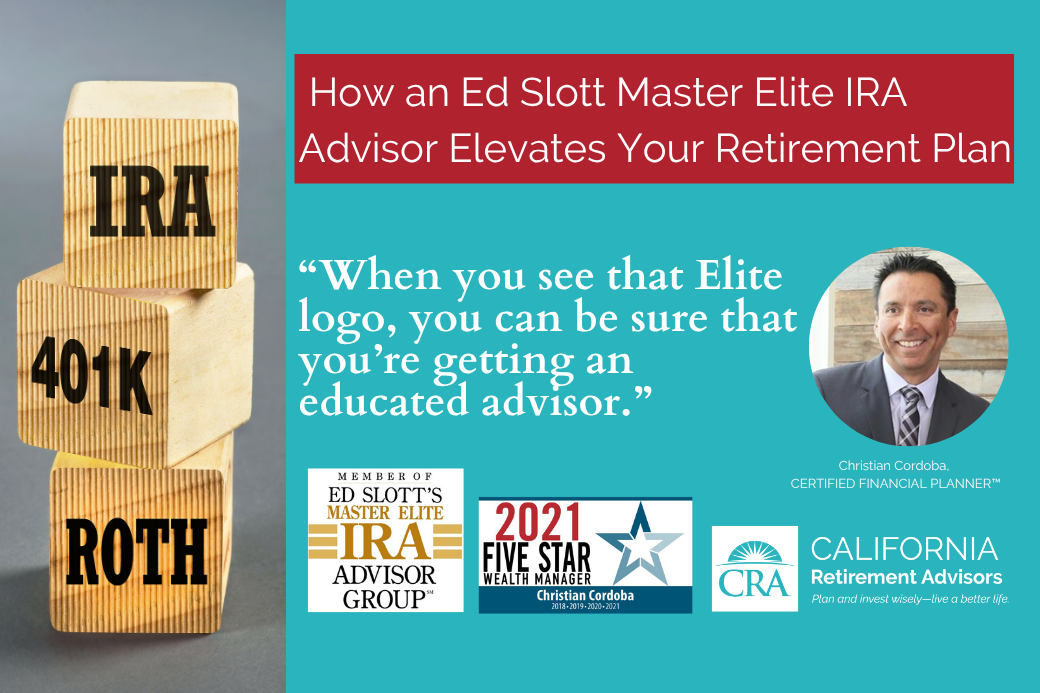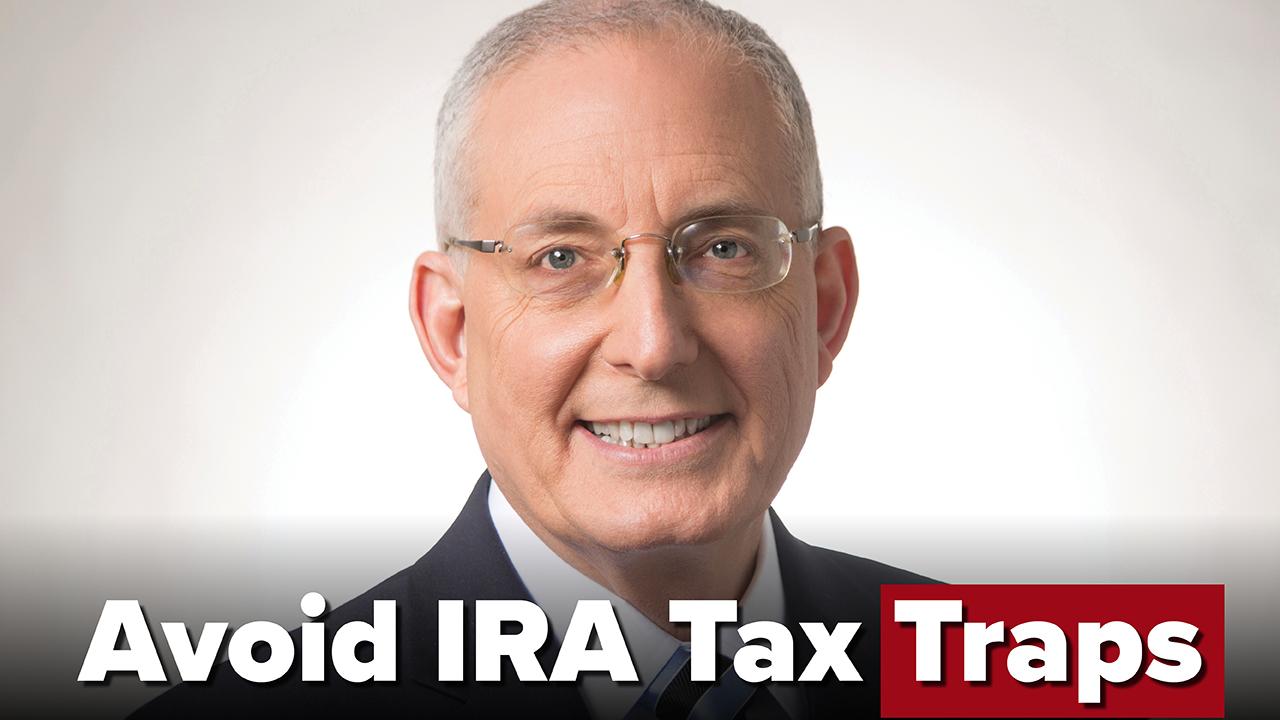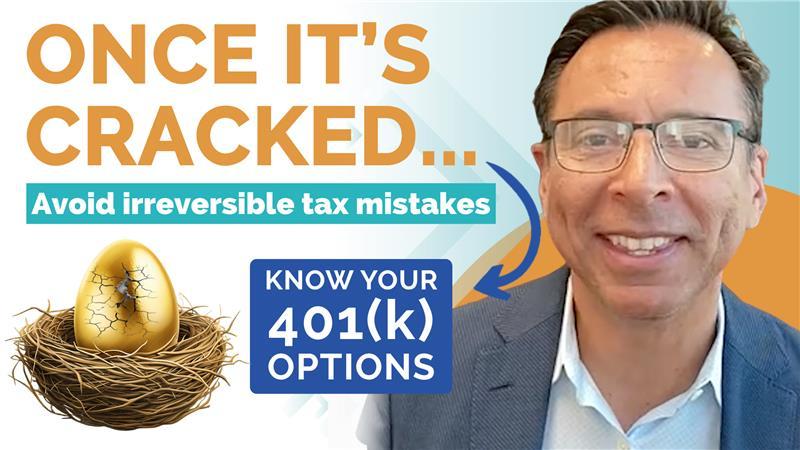
IRA & Retirement Plan Dollar Limits Increased for 2026
The IRS has released the cost-of-living adjustments (COLAs) for retirement accounts for 2026, and many of the dollar limits will increase next year.
241 posts matched your search

The IRS has released the cost-of-living adjustments (COLAs) for retirement accounts for 2026, and many of the dollar limits will increase next year.

On November 13, 2025, the IRS announced the 2026 COLA limits for IRAs and retirement plans. Here are the 2026 limits for SIMPLE IRAs.

The IRS has issued guidance on Trump Accounts, which are new tax advantaged accounts for children established as part of the One Big Beautiful Bill Act (OBBBA).

Do annual RMDs apply to inherited Roth IRAs? It depends on the type of beneficiary.

At CRA, we’re proud that Chris Cordoba is a member of Ed Slott’s Master Elite IRA Advisor Group℠ — a distinction earned by only a select group of advisors nationwide.

Think your IRA is all yours? Think again. It’s actually a joint account with Uncle Sam—and one wrong move could cost you thousands in unnecessary taxes.

Rolling over your old 401(k) or 403(b)? One wrong move could quietly cost you thousands in unnecessary taxes and penalties — especially in California’s high-tax environment.

A few months ago, the IRS introduced a new Code Y for the reporting of qualified charitable distributions (QCDs) by IRA custodians on the 2025 Form 1099-R.

When a trust is named as beneficiary of an IRA, several possible negative issues may be introduced.

Most probably know about the SECURE 2.0 Act provision permitting 529 funds to be rolled over to Roth IRAs. But this rollover opportunity comes with several restrictions.

At their core, IRAs and 401(k) plans operate in a similar fashion. It is these fundamental similarities that create a false narrative that IRAs and 401k) plans are essentially the same.

While naming a spouse directly as the IRA beneficiary has many advantages and is a popular choice, it is not always the correct planning strategy.

Don’t miss out on Roth IRA benefits by making mistakes when you take a distribution. Here are five steps for tax-free Roth IRA distributions.

This is the time of year when tiny ghosts and goblins will ring doorbells and ask, “Trick or Treat?” Which of the following IRA strategies are “treats” and which are just “tricks?”

The plan RMD must be taken prior to any rollover. If the plan RMD is erroneously rolled over, it is now an excess contribution in the IRA, and that error must be corrected.

There are often discussions about tax credits and 529 plans savings plans, but one tool that that you might overlook is the Coverdell Education Savings Account (ESA).

Normally, if you declare bankruptcy, your IRA funds are completely off limits to bankruptcy creditors. But this isn't always the case.

Traditional and Roth IRA owners often get confused about the distributions they take from their IRAs.

There is no “SECURE 3.0” in this legislation. It does NOT contain any changes DIRECTLY related to IRA or retirement plan rules.

When there is a mix of pre- and after-tax dollars, you cannot withdraw (or convert) just the non-deductible funds and pay no tax.

President Trump signed the One Big Beautiful Bill Act (OBBBA) into law on the Fourth of July. The $3.8 trillion tax and spending package is a wide-ranging piece of legislation.

As with most new laws, there are a number of unanswered questions about Trump accounts that need to be addressed by the IRS.

Which one should you contribute to? It turns out that each option has its own advantages.

The One Big Beautiful Bill Act (OBBBA), signed into law on July 4, makes some changes to the HSA rules.

On July 4, 2025, President Trump signed into law the “One Big Beautiful Bill Act” (OBBBA). What does it mean for your retirement account?

The One Big Beautiful Bill Act (OBBBA) signed into law on July 4, 2025, includes a new savings vehicle for children called “Trump accounts.”

Trump Accounts now join the ranks of the many ways Americans can save using individual accounts.

The IRS has introduced a new code for the reporting of qualified charitable distributions (QCDs) by IRA custodians on Form 1099-R.

Any distribution from any Roth IRA follows the ordering rules – contributions first, converted dollars second, earnings last.

You may need your IRA money to make homeownership happen, and there is a special break in the tax code that can help if you qualify.

Naming a trust is not something that should be done without a clear purpose. Here are six good reasons to name a trust as an IRA beneficiary.

What if an RMD gets erroneously converted? Is there a fix? Yes.

You are not alone if you have concerns that your IRA or workplace plan savings could be lost if you are forced to declare bankruptcy or wind up on the losing end of a civil lawsuit.

Health Savings Accounts (HSAs) may be one of the biggest tax breaks currently available.

Handling and tracking basis in your traditional IRAs can be challenging, but it is important to get it right.

If you have earnings, you can’t just take out the after-tax contributions to avoid paying taxes on a withdrawal. Instead, a pro-rata rule treats part of your distribution as taxable.

After-tax contributions are worth considering as they can significantly boost your retirement savings and can sometimes be funneled into Roth accounts while you’re still working.

There are currently 20 exceptions, with a 21st on the way. Here are those exceptions, with some brief commentary.

In the 2022 SECURE 2.0 legislation, Congress gave the IRS two years, which have come and gone, to come up with rules allowing IRA owners to fix certain mistakes through self-correction.

When you file for bankruptcy, one thing you usually don’t have to worry about is protecting your IRA funds from your bankruptcy creditors.

There is still time beyond the April 15 deadline. Here are three retirement account moves for the 2024 tax year that are still available to make in 2025.

There is still time! You can still make a prior-year (2024) IRA or Roth IRA contribution up to the tax filing due date, April 15, 2025.

Recent turmoil in the markets has hit many retirement savers hard as they see their IRA and 401(k) balances rapidly shrinking.

If I retire in the year when I turn 73 (or older) and want to directly roll over my 401(k) funds to an IRA, do I have to first take a required minimum distribution (RMD) from my 401(k)?

The arrival of the SECURE Act means the end of the stretch IRA for many beneficiaries.

Do you get a separate elective deferral limit for your pre-tax and Roth contributions to each plan?

Here are a handful of creative “detours” that retirement account owners may be forced to take in order to reach their intended goal.

More and more 401(k) plans are making Roth employee contributions available, and employees leaving their jobs often want to roll over Roth 401(k) funds to a Roth IRA.

In June 2014, the U.S. Supreme Court ruled that inherited IRAs are NOT protected in bankruptcy under federal law, citing three primary characteristics of inherited IRAs were not features of a “retirement” account.

Oftentimes people think they can roll a 401(k) RMD to their IRA and simply take that plan RMD from the IRA later in the year. Incorrect.

Tax season is upon us! If you are thinking about making a contribution, here are 10 things you need to know.

Here are a handful of transactions where a 1% shortfall can cause the entire house of baseball cards to come tumbling down.

The distribution rules for taxation of Roth IRA distributions can be complicated, but if they are followed, the reward is tax-free withdrawals in retirement.

If you don’t fix the error by that date, the tax consequences are serious. Having a tax filing extension for 2024 does NOT give you more time.

Personal finance includes managing your money as well as saving and investing. It encompasses budgeting, banking, insurance, mortgages, investments, and retirement, tax, and estate planning.

Keep in mind that these are the rules for IRAs inherited after 2019. (Pre-SECURE Act rules apply for IRAs inherited before 2020.)

Planning an IRA rollover across calendar years? Learn how to report it, avoid tax mistakes, and stay within rollover limits to protect your retirement savings.

With all plan dollars rolled over to an IRA, future IRA RMDs can be sent to whatever qualifying charity you wish via QCD. But until the plan dollars are in that IRA, we must do this plan RMD/rollover timing/QCD dance.

Monday was Inauguration Day. We also have a new Congress. When it comes to retirement accounts, one rule that the new Congress should consider changing immediately is the income limit rule that applies to Roth IRA contributions.

There are a number of restrictions when it comes to moving money from a 529 plan to a Roth IRA.

Health Savings Accounts (HSAs) continue to become more popular. Here is what you need to know about taking tax-free HSA distributions.

You will want to be sure to get the following three IRA-related tasks done sooner rather than later to avoid penalties and missed opportunities.

Here’s something you can only find in the Internal Revenue Code: Starting in 2025, there will be not one, not two, but three different catch-up limits for older SIMPLE IRA participants.

Explore Roth IRA conversions, their tax implications, and essential considerations for effective retirement planning.

New IRS rule: You must take all aggregated IRA RMDs before completing a Roth conversion. Avoid excess contributions and IRS penalties.

With that reminder comes another: pay attention to the Roth IRA distribution clocks. The key point to remember is that there are two different clocks, each used for a different purpose.

The get-out-of-jail card that has allowed many IRA and plan beneficiaries to forego annual required minimum distributions (RMDs) is about to expire.

When it comes time to roll all these plan dollars to an IRA, where should (and where can) the different dollars go?

IRA recharacterization still applies to contributions—not conversions. Learn how and when to fix an IRA contribution mistake by the October 15 deadline.

Learn how new IRS rules affect penalties for missed RMDs and excess IRA contributions, including critical statute of limitations updates under SECURE 2.0.

Learn how IRA withholding works, your options, and the risks of underpayment. Make informed tax choices with this essential IRA distribution guide.

So that everyone knows which end is up, here is a spiked punch bowl of common retirement-account-related acronyms.

The recent final required minimum distribution (RMD) regulations include a new rule change that may be beneficial for IRA owners who name trusts as beneficiaries.

Discover the IRS tax relief and retirement withdrawal options for victims of Hurricanes Helene and Milton. Learn about penalty-free IRA withdrawals, extended tax deadlines, and SECURE 2.0 benefits.

Recharacterization of IRA contributions is still available and can be helpful in many situations you may find yourself in.

While you may not have avoided the excess contribution penalty for this year, you can still correct the issue for future years.

Understand the tax rules behind NUA strategies. Learn how timing, cost basis, and Roth conversions impact long-term gains and penalties.

In 2020, the SECURE Act completely changed the game for nonspouse IRA beneficiaries. Here is some good news if you are inheriting a Roth IRA.

Knowing which dollars are available tax-free and which dollars are still bound by a 5-year clock could save some heartache when it comes to tax time.

Under the SECURE Act, a minor child of the account owner is considered an eligible designated beneficiary and can stretch distributions from an inherited IRA over their life expectancy until reaching age 21.

Learn how the 5-year rule impacts non-spouse beneficiaries of inherited Roth IRAs. Know when distributions become tax-free and what ordering rules apply.

The issue is whether a retirement account beneficiary subject to the 10-year payout rule who inherits from an IRA owner after the owner had started RMDs must continue annual RMDs during the 10-year period.

If you have multiple traditional IRAs and want to do a 60-day rollover (or Roth conversion) in a year when a required minimum distribution (RMD) is due, the IRS has a surprise for you.

Learn how the new IRS rules for aggregating year-of-death RMDs impact IRA beneficiaries and distributions after the owner's death.

While you have been saving for retirement, you may not have thinking about what happens to your IRA after your death.

Learn the 12 key rules for Qualified Charitable Distributions (QCDs) to maximize tax-free charitable giving from your IRA in 2024.

Discover when a reverse rollover from an IRA to a 401(k) makes sense. Learn how this strategy can help you minimize taxes and maximize retirement benefits.

More and more Americans have retirement savings in Roth 401(k)s. With their rising popularity come some complicated tax issues.

Learn about penalty-free 401(k) & IRA withdrawals under SECURE 2.0. Understand eligibility, limits, repayment options, and tax implications.

If too much money is deposited into a particular IRA, those excess funds must be removed from the same over-flowing IRA to avoid penalties.

After more than two years, we might actually be getting answers from the IRS on several important unanswered questions concerning RMDs for those who inherit IRAs or company plan accounts. Learn about the upcoming IRS Beneficiary RMD Final Regulations, changes from the SECURE Act, and how they impact your retirement account inheritance planning.

With beer pong, there are a number of permutations and in-house rules that can apply. Such is the case with IRA custodians, as there are different in-house rules for different scenarios.

Learn the essential facts about Required Minimum Distributions (RMDs) for your IRA. Understand RMD rules, deadlines, calculations, and penalties. Get expert advice to manage your retirement savings effectively.

SECURE 2.0 made some significant changes to the SIMPLE IRA plan contribution limits, pushing the 2024 limits to $17,600 and $3,850, respectively.

Understand Roth 401(k) to Roth IRA rollover rules, 5-year clocks, and tax implications to avoid costly mistakes and maximize retirement savings.

Find out how the one-rollover-per-year rule affects your IRA transactions. Learn about the regulations around IRA rollovers, including the one-rollover-per-year rule, and how to navigate these rules for effective financial planning.

Retiring at age 73 or later? Learn how 401(k) RMD rules apply before rolling over to an IRA and how to avoid excess contribution penalties.

In its proposed SECURE Act regulations, the IRS surprised everyone by saying that, in addition to the 10-year payout, annual RMDs are required in years of 1-9 of the 10-year period if the IRA owner had died on or after the date his RMDs were required to begin.

Discover how community property laws impact your IRA. Learn about key considerations for IRA owners in community property states, including divorce and beneficiary designations. Get expert advice to navigate these complex issues.

Here’s a cheat sheet on how the SECURE Act rules currently stand for IRAs inherited after 2019.

Explore four ways to reduce taxes on your required minimum distributions. Keep more of your retirement savings with smart planning.

Prepare for the 2024 tax season with our comprehensive to-do list. Learn essential tax filing tips, gather necessary forms, and maximize your deductions with expert advice.

Guess what’s on sale right now? Taxes. The taxable income brackets for 2024 (ordinary income tax rates) are as follows.

Learn how to correct excess IRA contributions, avoid penalties, and stay compliant with IRS rules. Understand deadlines, penalties, and IRS Form 5329.

Learn whether 529-to-Roth IRA rollovers are subject to state tax. Explore state-specific rules and their tax implications under SECURE 2.0.

If you exceeded the 2023 limit for 401(k) deferrals, time is of the essence to correct the error. If you don’t act quickly, the tax consequences can be serious.

Learn the key rules when a trust or estate is named IRA beneficiary—how it affects ownership, RMDs, tax treatment, and account setup.

IRAs are an important, but often overlooked, part of your overall tax planning. As the deadline for filing 2023 tax returns approaches, it is a good time to incorporate your IRA plan strategies with your overall tax plan.

In less than 26 months, nearly two dozen TCJA provisions are slated to expire unless Congress intervenes. The ramifications? We stand at the brink of one of the most impactful tax reconfigurations in recent memory.

The IRS has now said that rollovers done before April 15, 2024 can count as Roth IRA contributions for tax year 2023 if the 529 beneficiary has not already maxed out on his 2023 IRA contribution limit.

Wondering where to report 2025 Roth IRA contributions on your tax return? Learn key details, deadlines, and tax implications for Roth IRAs.

SECURE 2.0 allows IRA annuities and other IRA funds to be combined for RMDs. A proper annuity valuation is required to apply the new rule.

Explore financial aid options for disabilities, including tax deductions, credits, ABLE accounts, and special needs trusts to ease financial burdens.

If you have the means, a little can become a lot. It’s not about timING the market, it’s about time IN the market. If a teenager starts early, the long-term benefits could be astronomical.

Despite the upheaval of the IRA beneficiary rules, the payout rules still apply when a non-designated beneficiary inherits an account. Read the details.

Contributing to an IRA may seem pretty straightforward, but there can be twists. Here are four rules that may surprise you when you make your 2023 IRA contribution.

Thinking about a 2023 SEP IRA contribution? Here are 6 rules to help you educate yourself and decide whether or not to continue with such a contribution.

SECURE 2.0 established a six-year SOL on the 6% excess IRA contribution penalty and a three-year SOL on penalties for missed required minimum distributions (RMDs).

If you are charitably inclined and have an IRA, you might want to consider doing a Qualified Charitable Distribution (QCD) for 2023. The deadline for a 2023 QCD is fast approaching. It is December 31, 2023, but many custodians have even earlier cutoffs.

The SECURE 2.0 Act contained over 90 sections and included numerous IRA and retirement account changes. Here is a list of 10 items from the Act scheduled to come on-line in 2024.

Since the 529-to-Roth rollover was not permitted until this year, it was anticipated that any nebulous language or confusion would be cleared up well before the 2024 calendar change. Well, it is a year later, and we have received no guidance from the IRS concerning 529-to-Roth-IRA rollovers.

Congress made SIMPLE IRA plans more complex with new 2024 rules under the SECURE 2.0 Act. Learn how limits and contributions are changing.

What is the Backdoor Roth strategy? High-income earners - those over the Roth IRA income threshold can make non-deductible contributions to a traditional IRA and then convert the traditional IRA to a Roth, thereby circumventing the income limitations.

Discover essential 2024 tax tips from Certified Financial Advisor Christian Cordoba to reduce your taxes and grow your wealth. Learn about tax deductions, tax-efficient investing, and more.

The investment advisory firm of Bad Santa & the Grinch continues to disseminate misinformation and lousy, no good, rotten-to-the-core IRA advice. These two unsavory characters take great joy in fouling up not only your holiday, but also the qualified status of IRAs.

In 2024, more Americans than ever before will reach age 65. This demographic milestone has been called “Peak 65.” If you are in this group, what does Peak 65 mean for your IRA?

IRA contribution limits rise to $7,000 in 2024. Learn new income thresholds, catch-up rules, and other IRA updates under SECURE 2.0.

An advisor called and said his 75-year-old client had just passed away. He had questions about the payout rules applicable to the three IRAs the client left behind: a traditional IRA, a Roth IRA, and an inherited IRA from his sister.

Learn how to handle RMDs when IRA investments are illiquid. Explore aggregation strategies, contribution options, and planning tips to avoid penalties.

The confusion about the Roth IRA distribution rules isn’t really surprising since there’s actually two clocks, each used for different purposes and each with different rules.

If the Grinch and Bad Santa both passed their FINRA Series 7 exam and decided to open an investment advisory firm, I’m pretty sure they would combine forces to intentionally deliver some of the WORST financial advice possible.

When it comes to our retirement accounts, we frequently complain about the negatives, such as the many IRA rules that are way too complicated and confusing. Let's change it up and take a few moments to give thanks for those IRA rules that work well and help us save for our families’ futures.

Section 327 changes the distribution rules for spouse beneficiaries of IRA (and workplace plan) account holders and is effective January 1, 2024. The result is that some of these beneficiaries will actually be in a worse position than they are in under the current rules.

The end of the year is not far away. That means the deadline is near for taking a required minimum distribution (RMD). Here is what you need to know if you have your own IRA or if you are an IRA beneficiary.

The once-per-year IRA rollover rule sounds pretty easy to understand. You may only do one IRA-to-IRA (or Roth IRA-to-Roth IRA rollover) per year (365 days). However, this rule is often misunderstood.

Roth IRA distributions are taxed in many different ways depending on if they are contributions, converted funds, or earnings. Learn the steps to determine tax on Roth IRA distributions, including rules for contributions, converted funds, and earnings. Maximize your tax efficiency now.

A Health Savings Account is a tax-advantaged medical savings account that helps people pay for qualified out-of-pocket medical expenses. What are the withdrawal rules for HSAs? Are there special considerations that must be taken into account?

Learn from James Caan's mistake with the IRA same-property rollover rule to avoid hefty tax penalties.

Traditional IRA owners are subject to RMDs beginning in the year in which they turn age 72. The RMD age used to be 70½, but the SECURE Act raised the age to 72 for anyone who turned 70½ in 2020 or later.

A QCD is a distribution from an IRA that goes directly to a qualifying charity and is not included in the taxable income of the IRA owner. A QCD cannot be made from an employer plan. A QCD can be up to $100,000 a year, per individual.

As advisor questions come in about the SECURE Act, SECURE 2.0 and the tax code, I get it when they ask, “Where does it say that?” But the “Where does it say that?” question is not an easy one.

An estate can become the beneficiary of a person’s IRA in a couple of ways. First, the estate could be named outright as the beneficiary on the beneficiary form. Another way an estate can become the beneficiary of an IRA is if no beneficiary is named at all.

Did you inherit an IRA from someone who is NOT your spouse? If this is your situation, proceed with caution! For non-spouse beneficiaries, a wrong move can result in disastrous consequences.

When taking a distribution from a Roth IRA, this is the order in which the dollars come out, 1 through 3. You cannot access your converted dollars until the contributions have been depleted, and you cannot access any earnings until both the contributions and conversions are gone.

Taxpayers naturally seek to use benefits offered in the Internal Revenue Code. Sometimes, though, Code provisions offset each other, reducing the expected tax savings. Fortunately, savvy planning can help seniors receive the best of both worlds.

Understand key reasons to reject a pension lump sum buyout. Interest rates, life expectancy, and tax impact matter when making this decision.

Maybe you made a Roth IRA contribution for 2022 and then discovered your income was too high. You’d rather contribute to a Roth IRA or maybe not contribute at all. You can fix these issues by correcting your 2022 IRA contribution by the upcoming October 16, 2023, deadline.

The Ed Slott team answers thousands of IRA and work plan questions annually. Here are 10 IRA and work plan topics that you may have stumbled across yourself.

The lunacy of IRA beneficiary payout rules continues to boggle the mind. As I guide advisors through the options available to their clients, various nuances present one unique scenario after another. Did the original IRA owner pass away before or after the establishment of the SECURE Act? How old was the person when they died? Who was the beneficiary? Is this a successor beneficiary situation? Ultimately, by following the individual fact patterns, definitive answers materialize.

In the past, a person needed to route after- or pre-tax dollars through a traditional IRA, but this is no longer the case. With "Mid-Air" Roth Conversions, it can be done from company plans. Read more.

If you are thinking of buying an NFT (non-fungible token) with your IRA funds, you may want to reconsider. In Notice 2023-27, the IRS said that NFTs associated with “collectibles” are prohibited IRA investments. This could expose you to significant taxes and penalties.

Discover the 7 essential rules for inherited IRAs that non-spouse beneficiaries need to know. Learn about contributions, distributions, taxes, and more.

Learn about Required Minimum Distributions (RMDs) and Qualified Charitable Contributions (QCDs), their tax benefits, deadlines, and rule changes under SECURE 2.0.

As already-complicated IRA rules spiral further into an abyss of confusion, it comes as no surprise that irregularities exist. Here are three such random anomalies and exceptions baked into the “arbitrary” lines of the tax code.

When a contribution is not permitted in an IRA, it is an excess contribution and needs to be fixed. Some excess contributions are pretty easy to understand. Others are a little more complicated. Here are 5 ways an excess IRA contribution can happen.

If you are subject to required minimum distributions (RMDs) and have annuitized part of your IRA, a recent law change could drastically reduce your RMDs. But, without IRS guidance, it may be difficult to take advantage of that change.

If you inherited an IRA between 2020 - 2023, your RMD (Required Minimum Distribution) penalty may be waived by IRS Notice 2023-54.

Whether it is making smoothies, serving tables, or being a camp counselor, a summer job can teach life skills and give a first opportunity to manage finances. An important part of managing finances is saving for the future.

If you created your trust before 2018, and named your trust as the beneficiary of your IRA, you NEED to review it now. What was a perfectly effective planning strategy a couple of years ago could be totally useless now.

Another option is to keep your funds in the plan. Keep in mind, though, this may not always be possible. With that in mind, here’s several reasons why you may want to keep your plan funds where they are.

Understand required minimum distributions (RMDs), IRS updates, tax penalties, and smart withdrawal strategies for inherited retirement accounts.

The rule is often explained by saying that you can’t do more than one IRA-to-IRA (or Roth IRA-to-Roth IRA) rollover in any one-year (365-day) period. That’s an easy way of describing it, but it’s not always accurate. A better explanation is to say you can’t do a rollover of an IRA distribution made within one year of a prior distribution that you rolled over.

This requirement of annual RMDs when an account owner dies on or after the RBD stems from a rule sometimes called the “at least as rapidly” (ALAR) rule. While the ALAR rule does not require the same amount that was taken by the IRA owner to also be taken by the beneficiary, it does require that the process of taking RMDs continue.

In Notice 2023-43, the IRS said that self-correction for IRAs can’t be used until the IRS issues rules for the new program. And those rules aren’t required to be issued until the end of December 2024.

I thought about what might qualify as poison-ivy equivalents for IRAs. What transactions or situations present themselves as non-life-threatening nuisances that must be dealt with? Here are 4 pain-in-the-tail IRA annoyances.

What are the tax consequences when a Roth IRA is split in divorce? It is our (Ed Slott's team's) opinion that the inherited IRA should continue using the original beneficiary’s single life expectancy (the son’s).

If the original IRA owner named contingent beneficiaries on the beneficiary form, those names are null and void if the primary beneficiary is still alive when the owner dies. Assuming the primary beneficiary does not disclaim any portion of the IRA, the names on the contingent line become meaningless. The moment an IRA owner dies, the primary beneficiary is immediately deemed to be the new owner of those assets.

Rolling over to an IRA can offer many advantages, but everyone’s situation is different. Think carefully and weigh your options.

The biggest advantage that a spouse beneficiary of an IRA has over other beneficiaries is the ability to do a spousal rollover. With this, inherited retirement account funds become the spouse beneficiary’s own.

There are numerous articles referring to “eligible designated beneficiaries” (EDBs), “non-eligible designated beneficiaries” (NEDBs), and “non-designated beneficiaries” (NDBs). As a basic refresher, the three SECURE Act IRA beneficiary categories (and their applicable payout rules), are as follows.

Beginning in 2024, SECURE 2.0 requires that certain high-paid 401(k) participants who want to make catch-ups must make them on a Roth basis. This means that the contributions will be made on after-tax pay, but the contributions and associated earnings can be distributed tax free if certain conditions are met.

Learn how to legally and securely name a minor as your IRA beneficiary with custodial accounts, trust options, and guardian guidance.

Employees with very high compensation cannot have their retirement plan benefits based on all of their pay. Instead, the tax code allows only compensation up to a certain dollar amount to be taken into account.

Find out when RMDs apply to inherited Roth IRAs based on beneficiary type. Learn how SECURE Act rules affect Roth IRA inheritance.

Do you have an IRA you are thinking about converting to a Roth IRA? Inheriting a traditional IRA will have very different tax consequences than inheriting a Roth IRA. Converting your IRA to a Roth IRA is really a gift to your beneficiaries.

With tax season officially upon us, make sure to keep these 7 tips in mind when filing.

Roth IRA distributions have changed by SECURE 2.0. Read what those changes are.

It's never too early to start looking at your tax obligations for the coming tax season. The information in this article is for the 2023 tax year, which most taxpayers will file in 2024.

RMDs and how they function have been altered as SECURE 2.0 has taken affect. Read to see how in this article.

Under SECURE 2.0, RMDs have changed in certain ways that are critical for you to understand.

When it comes to rollovers from 529 plans to Roth IRAs, there are new regulations when it comes to SECURE 2.0.

SECURE 2.0 updates allow charities as beneficiaries in special needs AMBTs, improving IRA stretch options for disabled or chronically ill individuals.

This article contains questions asked by members of Ed Slott's community that are answered by members of his staff.

SECURE 2.0 brings changes to RMDs in regards to Roth IRAs. Read how in this article.

A donor-advised fund can help you maximize your charitable deductions for the year. But did you know it also comes with additional tax benefits? Read on to learn more.

This article has questions about once-per-year rollovers and RMDs for inherited IRAs.

Whether you're taking a DIY approach to filing your taxes this year or working with a professional, here are 5 filing tips to help make things a little easier.

It's important to understand all the rules associated with distributions from your IRAs.

A clear explanation of this valuable exclusion and how it helps most homeowners.

A look at the estate tax advantaged trust, the Intentionally Defective Grantor Trust.

Questions about RMDs and SIMPLE IRAs are answered by Ed Slott's team in this brief article.

IRA deadlines are coming to an end as the year closes out. Make sure you are on top of all these to secure yourself for a successful 2023.

Your employer may offer you a Roth 403(b) plan. Before you start contributing, it’s important to understand where your money’s going and the tax implications this type of account will have on you now and into retirement.

Roth IRAs are already popular, and with new SECURE Act regulations, they have even more advantages. Read what those are!

SECURE 2.0 is designed to increase savings in IRAs and company plans for retirement planners and savers.

When it comes to contributing to an IRA, it's important to understand all the details involving your spouse's ability to contribute.

Under new regulations, if the original IRA owner died on or after his required beginning date (when lifetime RMDs begin), then any subsequent 10-year period for a beneficiary or successor beneficiary will require RMDs within the 10-year window.

Like a traditional IRA or 401(k), a 414(h) plan lets you save money for your retirement while also providing you with some tax benefits.

Ask these 10 essential questions to ensure your financial advisor has the expertise to manage your retirement and IRA planning confidently.

Whatever your reason for giving this year, it’s important to know how your charitable contributions can impact your financial plan. In fact, being strategic and intentional in your charitable contributions can create tax benefits for both you and your chosen charity.

As Thanksgiving approaches, QCDs are a great way to get some tax relief, as well as make a difference to those who need it most by giving of what you have.

While there are many tricky aspects to financial planning and retirement funding, here are some that are straightforward and greatly beneficial.

Learn the 3 exceptions to the pro-rata rule for IRA distributions. Discover how to reduce taxes with rollovers, QCDs, and QHFDs.

QCD's are a great way to give back to the community while also providing you with some tax relief.

You know you have to pay taxes, but did you know when you choose to pay them could make a big difference in your tax return? Start the new year off right with these must-know facts about your taxes (Psst, especially if you're a business owner!)

With all the incredible benefits that come with Roth IRAs, it's no wonder more and more people are converting to it.

There are a few IRA transactions that are easily missed, which this article will explain in detail.

Major disasters, like Hurricane Ian, cripples the economy. The Government can offer aid, such as the pushing back of taxes for a certain period of time.

There is an exception to the 10% early withdrawal penalty from your IRA if you are a first-time home buyer. Read more about it here!

The 50% penalty on missed RMDs in 2021 and 2002 have just been waived. What does this mean for your IRA?

If you are wanting to convert your IRA during this year, now is the time to do so or you won't be able to again.

From tips on excess IRA contributions to IRA rollovers, this article includes the major topics focused on at the most recent Ed Slott conference.

When rolling over from IRAs to other IRAs or Roths, it's important to understand the rules, especially the same property rule.

Charitable donations are used as tax write-offs, but they must be qualified distributions that abide by the guidelines.

Learn how Roth 401(k) distributions are taxed, including rules for qualified withdrawals, the 5-year rule, and how to calculate taxes on earnings.

It's not just once a year that you should be reviewing your IRA, but several times to check for important updates.

When a person is named the beneficiary from an inherited IRA, they have five years to empty that IRA. Learn more about this concept here.

Inheriting an IRA is a big responsibility, so understanding the rules and applications for such an item is critical.

Fitting different conversions into Traditional and Roth IRA buckets is the way for the IRS to know which is which.

October 17th is coming up quickly! Have you made sure recently that you have no excess IRA contributions? If not, now is the time to check, as well as fix it if you have not yet.

Inflation is on the rise; are these new taxes the solution?

Compare 403(b) vs. 457(b) plans to determine the best retirement savings option. Learn about contribution limits, tax benefits, and plan eligibility.

ERISA is a federal tax and labor law that establishes minimum standards for pension plans in the private industry. Read how it applies!

This article, cited from Ed Slott and Company, LLC, explains the ordering rules for Roth IRAs.

This article details the top three provisions in the Inflation Reduction Act that the average American will benefit from the most.

Mega backdoor Roth IRAs are complicated retirement savings strategies. But for the right person, they could offer a big tax advantage.

If you’re experiencing financial hardship or emergency, knowing the rules of the road for penalty-free retirement plan withdrawals is important.

Get familiar with your state’s estate laws so you’re well aware of which rules apply to you.

Having a tax-focused understanding of your investments is an important component of preserving wealth. Here are a few tips for high-earners.

Helping your clients with the year-round effort to maintain your tax strategy.

Required minimum distributions (RMDs) from retirement accounts were suspended in 2020, as part of the federal government’s effort to keep the economy afloat despite medical and financial turmoil. Now they’re back, so most people who are 72 or older in 2021 will have to take at least as much as IRS tables dictate from their retirement accounts this year, and pay the resulting tax. Many IRA owners delay RMDs until yearend, but there are good reasons to act sooner rather than later.

Now that required minimum distributions from retirement accounts are back for 2021 after being waived in 2020, you should look before you leap if you’ll owe RMDs this year. I’ll outline three commonly overlooked strategies by many retirement advisors, investment advisors, and financial consultants alike, that are good for you to at least know about especially if you own a large IRA. Note that this recommendation applies not only to most account owners who are 72 or older in 2021 but also to retirement account beneficiaries subject to RMDs.

Apple, Tesla & McCormick all have one thing in common – they announced stock splits this year. Should you take advantage of these more affordable shares? Here are 3 things consider, plus if you should own shares within Non-IRA, IRA, or Roth IRA.

Part of the Build Back Better bill is a refundable 30% tax credit for certain types of e-bikes. The desire is to position e-bikes alongside electric cars and electric buses as a carbon-neutral transportation option. There are limits, and we explore them in this article.

Californians may experience the country's first-ever wealth tax. Here's what you need to know right away about this proposed bill.

Moreover, legislation passed in 2020 allows tax deductions up to 100% of adjusted gross income (AGI) for cash contributions, this year only. Normally, such deductions are capped at 60% of AGI.

While they’re both worth getting excited over, it’s important to understand the fundamental differences between tax credits and tax deductions.

The CARES Act provided economic benefits in direct response to COVID-19. Read on to learn five ways you can access these benefits for the 2020 tax year.

The 2022 tax season is officially here. If you haven't already, now is the time to get prepared to help lower your taxes.

The Social Security Administration announced a 2021 Cost of Living Increase of 1.3% on Oct. 13, 2020. Whether you’re currently working or enjoying retirement, here’s how you may be affected.

The 2020 presidential election results could have a profound impact on your estate and gift tax obligations moving forward. Here's what you need to know at year-end and beyond.